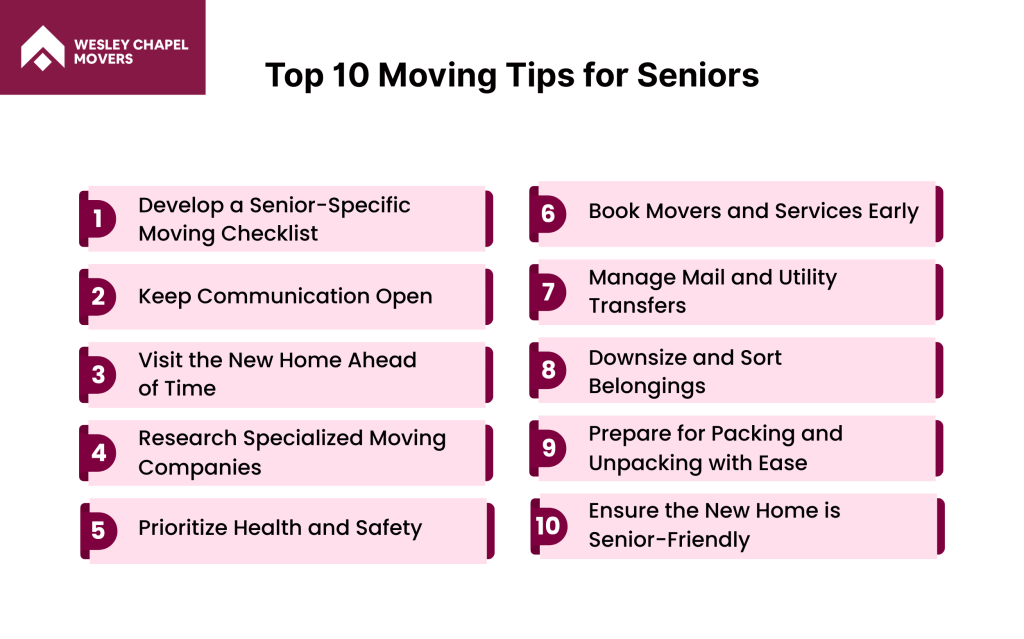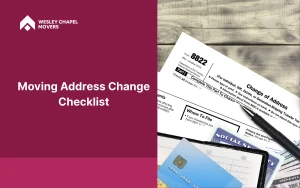Moving later in life can be challenging, especially for seniors, because it often means leaving behind a familiar home, managing health needs, and adapting to a new environment. Seniors face unique difficulties such as mobility limitations, medication requirements, and the emotional weight of downsizing personal belongings. To make this transition easier, moving tips for seniors focus on reducing stress, improving organization, and creating a safe and comfortable experience.
A smooth senior move depends on balancing planning, safety, and emotional support. Downsizing helps simplify the moving process while keeping meaningful items accessible. Hiring specialized movers, including senior move managers, reduces physical strain and ensures the sensitive handling of belongings. Preparing the new home, whether it is a retirement community, an assisted living facility, or a smaller residence, is equally important so that it remains accessible and supportive of senior needs. With the right planning and guidance, seniors can maintain dignity, reduce anxiety, and feel more comfortable as they settle into their new surroundings. Here are the 10 most important moving tips for seniors:
- Develop a Senior-Specific Moving Checklist
- Keep Communication Open
- Visit the New Home Ahead of Time
- Research Specialized Moving Companies
- Prioritize Health and Safety
- Book Movers and Services Early
- Manage Mail and Utility Transfers
- Downsize and Sort Belongings
- Prepare for Packing and Unpacking with Ease
- Ensure the New Home is Senior-Friendly
Develop a Senior-Specific Moving Checklist
A senior-specific moving checklist includes tasks that help make the relocation safe, organized, and supportive for both seniors and caregivers. This checklist balances the logistical side of moving, such as booking movers, packing, and confirming documents, with the emotional side, including downsizing sentimental items and planning for comfort in the new home. By starting early, seniors and their families can break the process into clear steps, avoid last-minute stress, and ensure that important health, safety, and accessibility needs are addressed along the way.
Two Months Before the Move:
- Check home accessibility: Make sure the new home has features like wide hallways or ramps for easy movement, even if mobility issues are not present yet.
- Get moving quotes: Request in-person or video walkthroughs from moving companies to receive accurate estimates and avoid surprises later.
- Sort and organize belongings: Begin decluttering, deciding what to keep, donate, or pass down to family members.
- Book movers early: Reserve your moving date in advance, especially during peak moving seasons, to avoid extra cost and limited availability.
One Month Before the Move:
- Make a list of valuables: List down all of the important items that must come to the new home.
- Reconfirm moving arrangements: Double-check times and dates with your movers to prevent scheduling issues.
- Begin packing documents: Secure medical records, legal paperwork, and valuables in a safe folder.
- Consult physicians: Update prescriptions and notify healthcare providers of the upcoming address change.
One Week Before the Move:
- Pack medications: Keep prescribed medicines in a clearly labeled, easy-to-access place to avoid it from getting lost.
- Set up a donation pickup: Arrange for charities to collect items you no longer need.
- Forward your mail: Notify the post office, insurance providers, and billing companies of the new address.
Moving Day:
- Verify your movers: Confirm you are working with the correct moving company by checking their truck and uniforms.
- Do a walkthrough: Inspect the old home with your agent or landlord before leaving.
- Review documents: Carefully read and sign moving paperwork, asking questions if anything is unclear.
Keep Communication Open
Communication is the key during any move. Therefore, keeping communication open ensures that seniors feel informed, supported, and respected throughout the moving process. Caregivers should patiently explain each step, encourage the senior to share their feelings, and involve them in decision-making so they feel included rather than overwhelmed. At the same time, coordinating with family members, movers, and healthcare providers keeps logistical details clear and avoids misunderstandings. By maintaining sensitive and supportive communication with everyone involved, caregivers create an environment where seniors feel safe, less anxious, and more confident about their transition to a new home.
Visit the New Home Ahead of Time
When you have time, visit the new home ahead of time with the senior and help them familiarize themselves with the layout, making them feel more comfortable about the change. During this visit, caregivers and family members can assess accessibility needs, such as safe bathroom setups, ramps, or wide doorways, and arrange for improvements before moving day. Walking through each space also allows the senior to visualize where their belongings will go, which makes the environment feel more personal and supportive. Beyond these practical checks, the visit provides important emotional reassurance by reducing anxiety, building familiarity, and giving the senior a greater sense of control over their transition to a safe and comfortable home.
Research Specialized Moving Companies
Working with a specialized moving company provides customized services for seniors, making relocation safer, more supportive, and less stressful. Unlike general movers, these companies often have experience handling mobility aids, fragile belongings, and the unique emotional challenges seniors face during transitions. They also offer additional services such as packing, unpacking, and setting up the new home, which eases the workload for caregivers and family members. However, choosing the right mover requires patience and careful research to ensure both reliability and sensitivity to the senior’s needs.
Follow these tips to choose a senior-focused moving company:
- Look for movers with experience in senior relocations and positive client reviews.
- Ask whether they provide extra services such as downsizing assistance or furniture setup.
- Confirm that they are insured and can safely handle fragile or valuable belongings.
- Request an in-person or video walkthrough to get an accurate and transparent quote.
Prioritize Health and Safety
Prioritizing health and safety ensures the moving process remains safe, supportive, and comfortable for seniors. This means preparing medications, mobility aids, and medical records in advance while also checking that the new home is accessible and secure. Simple adjustments such as adding grab bars, improving lighting, or creating clear walking paths can make the new environment safer and reduce the risk of falls. Some of the health and safety tips for a senior move include:
- Keep medications, prescriptions, and medical records in one clearly marked folder or bag.
- Ensure mobility aids like walkers or canes are packed for immediate use.
- Check the new home for safety features such as non-slip flooring, ramps, and grab bars.
Book Movers and Services Early
Movers and services should be booked well in advance to secure availability and reduce the stress that comes with last-minute arrangements. Early scheduling provides families with the time to research reliable moving companies, compare senior relocation services, and choose providers who understand the specific needs of elderly clients. It also helps avoid scheduling conflicts during peak moving seasons, ensuring the moving day runs smoothly. By confirming dates, costs, and responsibilities ahead of time, seniors and caregivers gain greater control over the process, making the transition feel safer, more organized, and less overwhelming.
Manage Mail and Utility Transfers
Mail and utility transfers should be arranged before the move to ensure a seamless transition and prevent disruption to daily life. Seniors and caregivers can reduce stress by notifying utility providers, such as electricity, water, phone, and internet, well in advance so services are active when they arrive at the new home. At the same time, setting up mail forwarding with the post office and updating addresses with banks, healthcare providers, and insurance companies keeps important communication reliable and uninterrupted. Taking these organized steps early makes the move safer and more supportive, giving seniors peace of mind that essential services will continue without interruption during their transition.
Downsize and Sort Belongings
Downsizing involves sorting belongings by importance and accessibility to make the move safer and more manageable. For seniors, this step reduces clutter, eases unpacking, and ensures only meaningful and useful items are brought into the new home. With supportive guidance from family or caregivers, belongings can be organized with sensitivity, allowing sentimental items to be preserved while unnecessary possessions are donated or sold.
Tips for Downsizing and Sorting include:
- Work through one room at a time for better organization.
- Divide items into groups: keep, donate, sell, or pass to family.
- Focus on frequently used and sentimental belongings.
- Schedule charity pickups to make donating easier.
Prepare for Packing and Unpacking with Ease
Packing should be done systematically, with essentials separated, to make the process more organized and less stressful for seniors. Starting early and packing non-essential items first while keeping personal items separate helps smooth the move and avoids last-minute pressure. Labeling each box with clear descriptions of its contents and the room it belongs in makes unpacking smoother, while fragile belongings should be handled with extra care to prevent damage. Here are some extra tips for packing and unpacking:
- Begin with non-essential items such as books, seasonal clothes, and extra linens.
- Pack essentials like medications, toiletries, and daily clothing in a clearly marked bag.
- Label boxes with both contents and the destination room.
- Wrap and pad fragile or sentimental items securely.
- Unpack essentials first, focusing on the bedroom and bathroom before other areas.
Ensure the New Home is Senior-Friendly
A senior-friendly home includes accessibility features like grab bars, ramps, and non-slip flooring that create a safe and comfortable environment. Making sure the new space supports the senior’s needs is essential for preserving independence and reducing risks during daily routines. Before the move, caregivers and family members should walk through the home together, checking for common safety needs such as well-lit hallways, secure bathroom setups, and clear walking paths that allow easy movement with mobility aids. Arranging these modifications in advance ensures that the senior can settle into a supportive and accessible space from the very first day. When seniors are involved in assessing the home and sharing their preferences, the transition feels more reassuring, and the living environment becomes both safer and more personally meaningful.
How to Choose the Right Moving Company for Senior Moves
To choose the right moving company for a senior move, focus on professionalism and empathy by verifying licenses, reading reviews, and checking whether they offer specialized services for older adults. A moving company should be experienced with senior relocations and provide support that meets both logistical and emotional needs. Key steps to choosing the right moving company for seniors include:
- Verify licensing and insurance to ensure the company is reliable and accountable.
- Read reviews and ask for references to confirm their track record with other families.
- Ask about specialized services such as packing, unpacking, or downsizing assistance.
- Request in-home or video surveys for accurate and transparent cost estimates.
- Check for proof of insurance coverage for belongings, especially fragile or valuable items.
- Look for signs of professionalism and empathy, such as respectful communication and patience during discussions.
Hiring professional movers makes the transition easier by reducing physical strain, managing heavy lifting, and handling belongings with care. For seniors, the right company not only ensures safety and organization but also provides supportive services that ease emotional stress. Families and caregivers can feel reassured knowing that experienced movers will create a smooth, respectful, and comfortable relocation that prioritizes dignity and independence.







